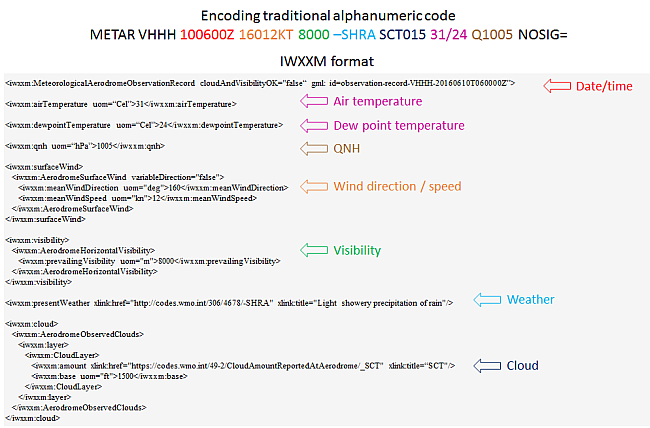ICAO Meteorological Information Exchange Model 101
ICAO Meteorological Information Exchange Model 101
LEE Yiu-fai and KOK Mang-hin
January 2019
'ABC of meteorological data encoding' in HKO Educational Resources points out that the traditional decoding method cannot effectively handle the exponentially increasing data exchange between meteorological centres. Higher fidelity meteorological data simply adds a further burden to the situation. The same thing also happens to Aeronautical Meteorology. In this regard, the World Meteorological Organization (WMO) set up a Task Team on Aviation XML in 2011 to join force with the International Civil Aviation Organization (ICAO) in formulating the next-generation standard on exchanging information for aeronautical meteorology –– this is the origin of the ICAO Meteorological Information Exchange Model (IWXXM).
What is IWXXM?
IWXXM is made up of two components, namely Unified Modelling Language(UML)conceptual model and eXtensible Markup Language(XML). In day-to-day operations, IWXXM can be considered as the conversion of Traditional Alphanumeric Code (TAC) into XML format for all meteorological products as stipulated in Annex 3 to the Convention on International Civil Aviation. Among the meteorological products, aviation weather reports (METAR), aerodrome forecast (TAF) and significant weather information (SIGMET) are some examples.

Figure 1 METAR encoded in IWXXM
Benefits of implementing IWXXM
The XML format facilitates information exchange among computer systems and conversion to other formats to fit for various purposes. XML is easily extensible to handle new information or data. The structure and metadata of XML also make data validation more efficient and effective. IWXXM will allow better exchange of aeronautical meteorological data, in line with the Aviation System Block Upgrade (ASBU) under the ICAO Global Air Navigation Plan, to support more advanced aeronautical meteorological services that require more accurate data in future.
IWXXM version 1.0 was first released in September 2013. The latest version 3.0 will be approved by WMO in mid-2019. IWXXM is expected to become mandatory from 2020 when Amendment 79 to ICAO Annex 3 becomes effective. Let's get ready for a data-booming era!